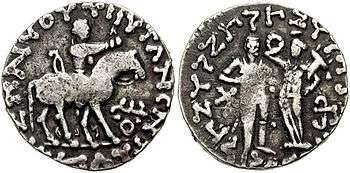Zeionises

Coin of Zeionises (c. 10 BCE – 10 CE).
Obv: King on horseback holding whip, with bow behind. Corrupted Greek legend MANNOLOU UIOU SATRAPY ZEIONISOU "Satrap Zeionises, son of Manigul". Buddhist Triratna symbol.
Rev: King on the left, receiving a crown from a city goddess holding a cornucopia. Kharoshthi legend MANIGULASA CHATRAPASA PUTRASA CHATRAPASA JIHUNIASA "Satrap Zeionises, son of Satrap Manigul". South Chach mint.
Obv: King on horseback holding whip, with bow behind. Corrupted Greek legend MANNOLOU UIOU SATRAPY ZEIONISOU "Satrap Zeionises, son of Manigul". Buddhist Triratna symbol.
Rev: King on the left, receiving a crown from a city goddess holding a cornucopia. Kharoshthi legend MANIGULASA CHATRAPASA PUTRASA CHATRAPASA JIHUNIASA "Satrap Zeionises, son of Satrap Manigul". South Chach mint.
Zeionises was an Indo-Scythian satrap of the area of southern Chach (Kashmir) for king Azes II.
He then became king, and ruled in parts of the Indian subcontinent around 10 BCE – 10 CE, but apparently lost his territory to the invasion of the Indo-Parthians.
His coins bear the Buddhist Triratna symbol on the obverse, and adopt representations of Greek divinities such as the city goddess Tyche.
A silver jug found at Taxila (Konow 1929: 81-83) indicates that Zeionises was "satrap of Chuksa, son of Manigula, brother of the great king", but who this king was remains uncertain.
| Preceded by: Azes II |
Indo-Scythian Ruler (c. 10 BCE – 10 CE) |
Succeeded by: Indo-Scythian satrap Kharahostes Kushan King: Heraios |
See also
References
- "The Shape of Ancient Thought. Comparative studies in Greek and Indian Philosophies" by Thomas McEvilley (Allworth Press and the School of Visual Arts, 2002) ISBN 1-58115-203-5
- "The Greeks in Bactria and India", W.W. Tarn, Cambridge University Press.
External links
This article is issued from Wikipedia - version of the 9/18/2015. The text is available under the Creative Commons Attribution/Share Alike but additional terms may apply for the media files.